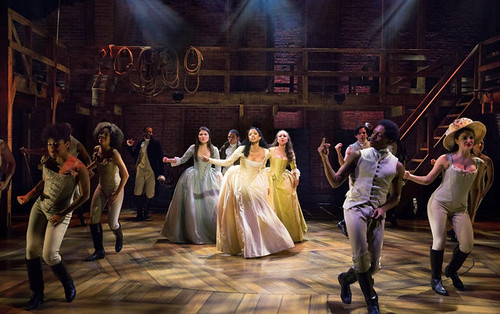Heads up, if you’re concerned about SPOILERS you might not want to read this…
Listen, it would have been really easy for Lin-Manuel Miranda to fuck this up. Broadway proves that to us all the time. Mostly men are writing and mostly men are directing and mostly men are producing. So it doesn’t feel like a coincidence that strong female characters are still just few and far between. For every Bea in Something Rotten!, there’s Betsy Nolan in Honeymoon in Vegas.
And sure, Miranda did well by women in In the Heights— Nina was the one getting up, out, and educated, after all. But In the Heights wasn’t… well, it wasn’t set during the Revolutionary War, for starters. The narrative constraints there were different. So there really was no guarantee of how we could expect Miranda to handle female characters in Hamilton. And high hopes tend to hurt me more than anything. So the first time I saw Hamilton I went into the theater feeling, well… cautious.
Good news, everyone. The Schuyler sisters passed the Bechdel test in their very first song! (Really good news, because actually, afterward, most convos do revolve around men, probably because… well, the story is about men.)
But really. The Bechdel test, for all that it offers, is a pretty limited look at the involvement of women in a piece of art, and there are tons of other factors that I consider important as a theatergoer. And it’s in those places where Hamilton shines. Where Hamilton is… dare I say it… revolutionary.
From the get-go, Miranda’s Schuyler sisters are fully formed characters, fully empowered within the constraints of the time-period in which the story is set. These are women “looking for a mind at work,” not just a handsome husband. They’re women who can acknowledge the reality of their circumstances — with no brothers, Angelica knows her job is to marry well, and wealthy — but still seek happiness, attraction and intellectual engagement. They’re as turned on by Hamilton’s brain, by the flick of his pen and his place in the revolution, as they are by his looks. And over the course of the show, they stand up for themselves and each other. Hell, when Hamilton cheats, Eliza takes control of the narrative.
In fact. That’s almost entirely literal. Because at the end of the show, Miranda performs what is perhaps his most powerful trick. As if the whole evening has been a glorious act of sleight-of-hand, Miranda takes the show from the men and places it securely in the mouths and minds of the women. He tells you that Eliza Hamilton dedicated herself to the preservation and propagation of Hamilton’s history. That, in fact, maybe this has been Eliza’s story all along. Not Hamilton’s, or Burr’s, but hers. She held the reins.
And that is no small truth to tell. But it’s also no small act of feminism to allow Eliza that moment on stage. Because it’s just as easy to tell Hamilton’s story without that moment. Nothing about the show would suffer. No one would even notice. Except, of course, Miranda himself. He’d notice.
It’s not bad to have a guy like him writing for Broadway right now. And sure, there are a million, zillion, hojillion reasons why that’s true. But the revolutionary women in Hamilton might well be my favorite among them.
Photo: Joan Marcus



{ 0 comments… add one }